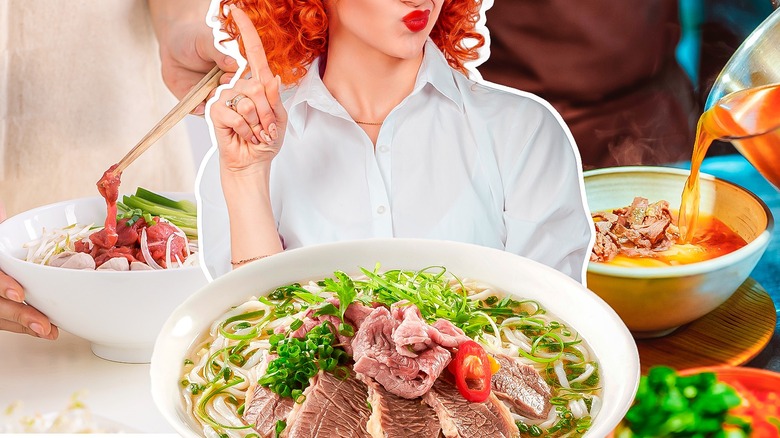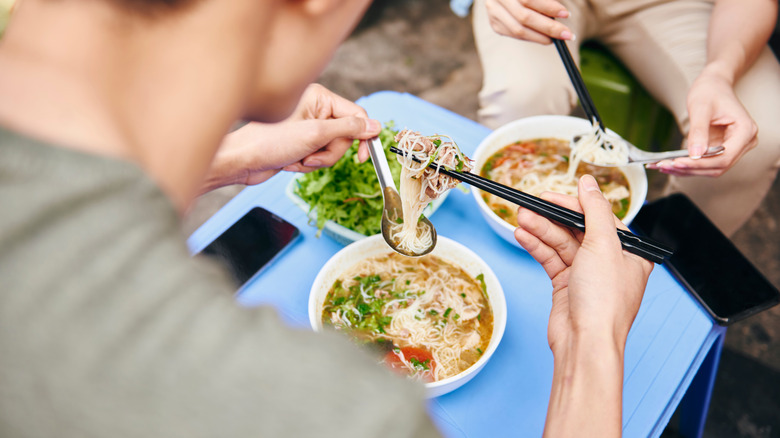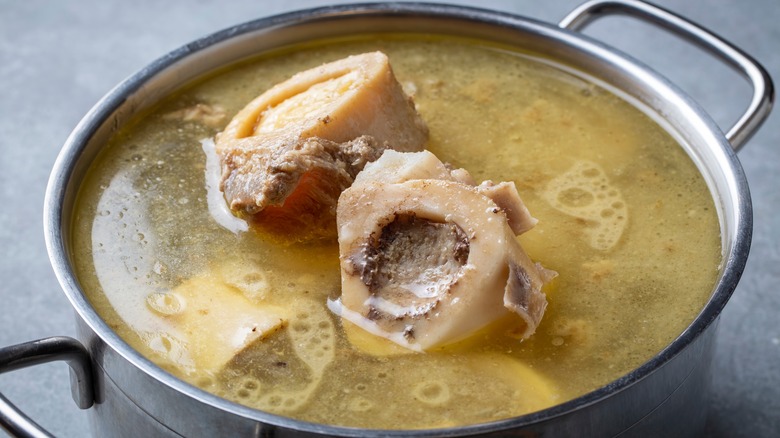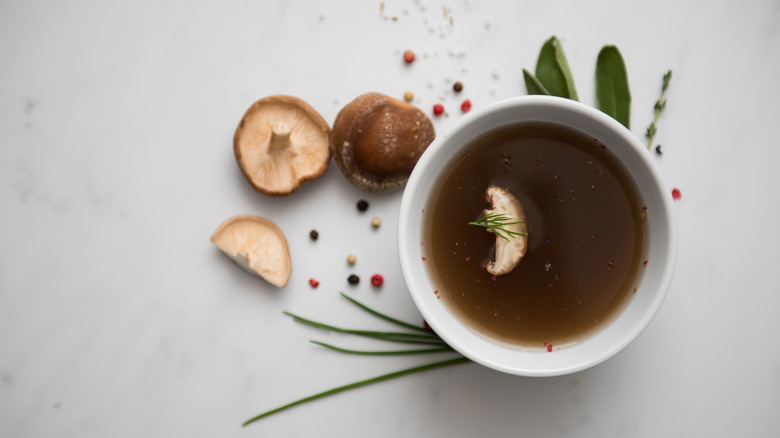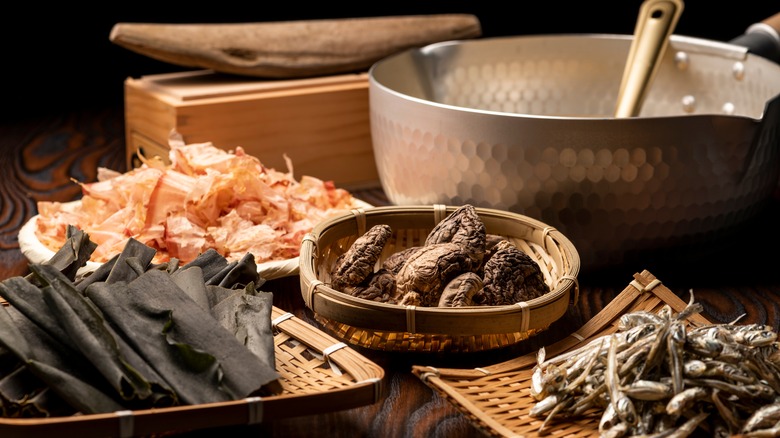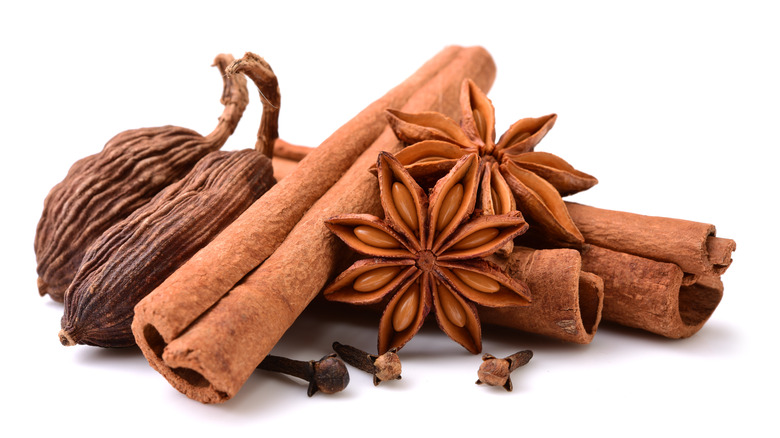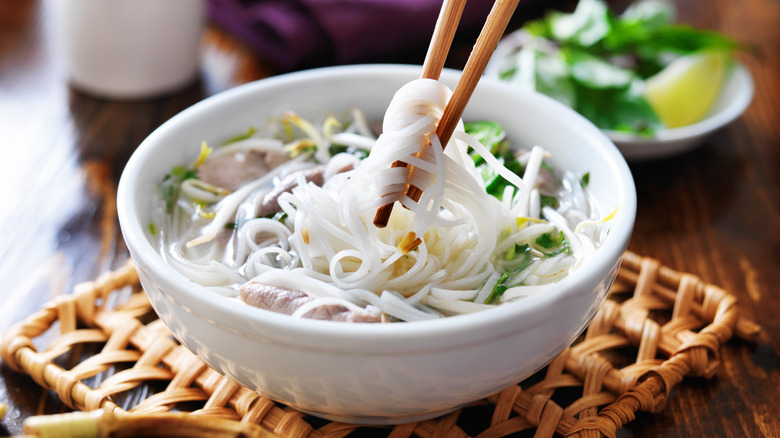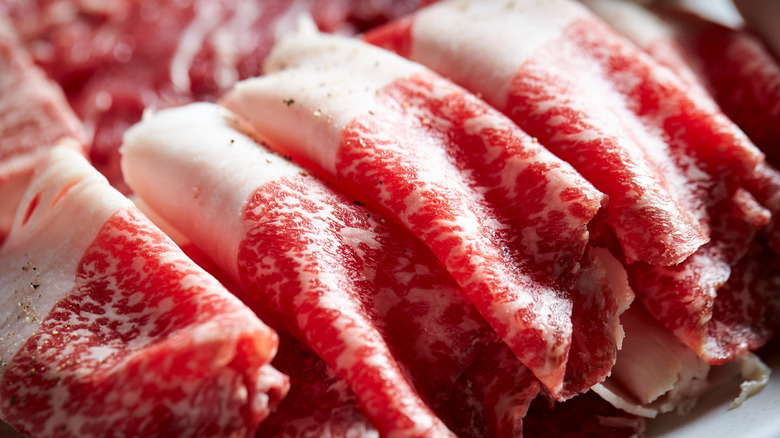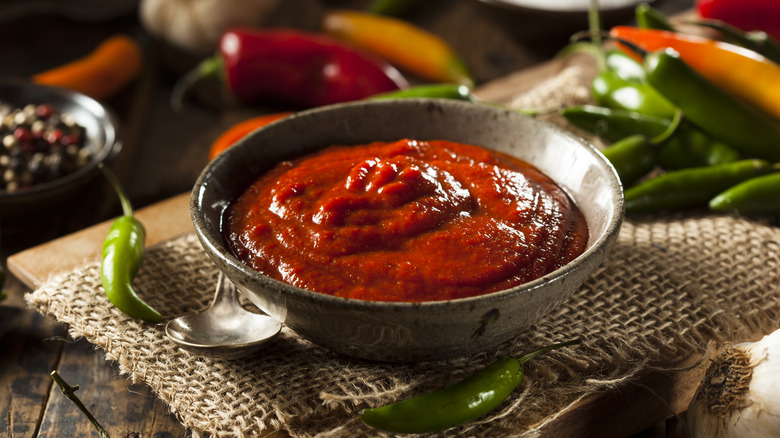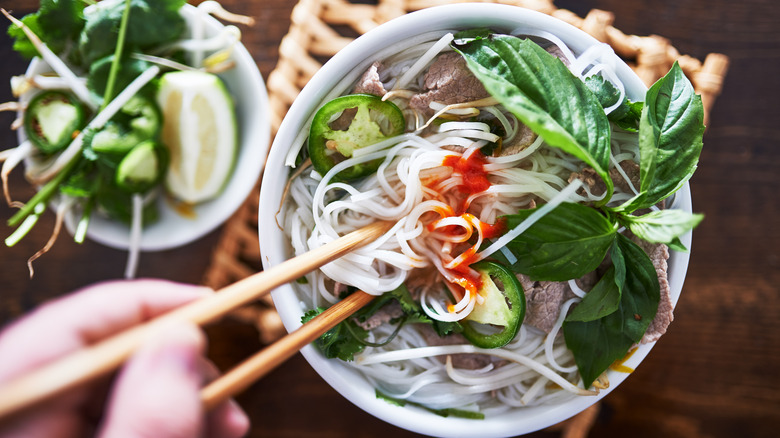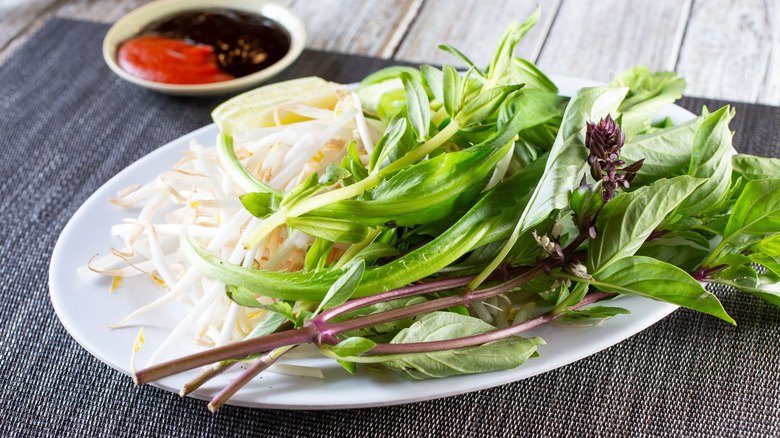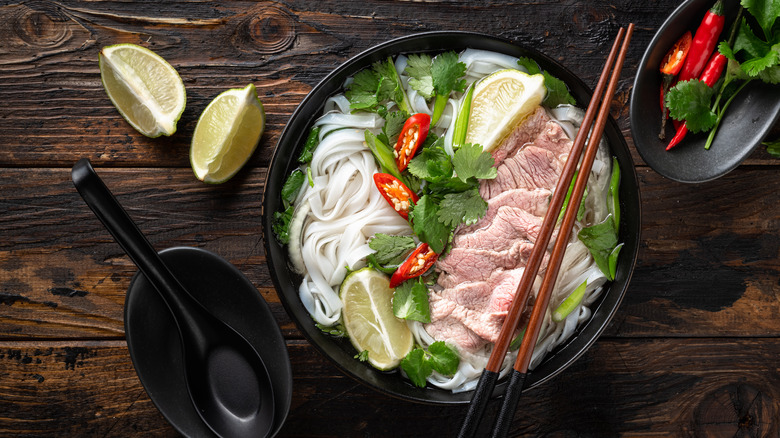11 Mistakes You Need To Avoid When Making Phở At Home
If you've ever sat down for a bowl of phở in a restaurant, you've probably been struck by just how versatile this dish can be. It's almost magical how a humble bowl of broth, noodles, and garnishes can come together into something as transformative as it is customizable.
Phở (pronounced "fuh" or like the French "feu") is a Vietnamese noodle soup with a murky history. It originated in the late 19th or early 20th century, most likely in North Vietnam near Hanoi. Rice noodles were already an established part of Vietnamese cuisine, but the use of beef — now the most typical ingredient for both phở broth and as a protein add-in — was influenced by the presence of French colonizers. Embellishments like herbs and citrus didn't occur until phở spread to South Vietnam in the 1950s, and it is that southern version that is the most known in the West today.
Phở makes the most of simple ingredients, and if you've got some time on your hands, it's a home-cooking project that's worth taking on. Dennis Ngo, chef and co-owner of Di An Di in Greenpoint, Brooklyn, has been making phở for years, and his restaurant offers a variety of styles for every taste. The good news for us? He's working on a new recipe and has been making a lot of phở at home. Chef Ngo gave us insights into the ingredients and techniques to help home cooks avoid phở-making mistakes and produce an incredible bowl at home.
Not knowing what kind of phở you're making
Before you start cooking, it's important to know whether you're making Hanoi or Saigon phở. Though both feature the basic combination of broth, noodles, and meat, you'll see some differences that set the two apart and will influence the ingredients you need on hand.
"In the North, they have a different broth style, which sometimes relies on a pork and beef mix," says Chef Ngo. "They'll add in a pork foot for the collagen." This combination of proteins helps create a lighter soup than one made strictly with beef. According to Andrea Nguyen of Viet World Kitchen, the use of pork was a wartime change when beef was scarce. Ngo also let us know that Hanoi-style phở is also lighter in terms of spice, resulting in an overall lighter dish. Saigon or southern phở has a more spice-forward flavor. The broth is more cloudy and garnishes like herbs, and sauces result in a bowl that is full of complex flavor and texture.
Cooking the broth too quickly
If there's one thing you need to know about cooking phở broth, it's that you can't rush the process. "The minimum time for me to get the quality of product that I enjoy is about eight hours," says Chef Ngo. And one more thing: "Never [let] it come to an aggressive rolling boil."
During that eight-hour cook, Ngo says you'll want to keep your broth between 190 F and 200 F. All that time and the low heat let the gelatin slowly cook out of the bones, giving you an unctuous mouth feel and lots of flavors.
For the very best results, Chef Ngo says to add another 12 hours to that cooking process. The night before, put your bones in cold water and soak them overnight. The next morning, dump the water and fill the pot back up with fresh water. "Let it boil for about 15 minutes at a really hard boil," says Ngo. "This is the only time you can let it run." This pre-cooking process will get the scum and impurities out of the bones so they're nice and clean before you start making your broth. Rinse the bones, then proceed to that gentle eight-hour cook time, knowing you'll have way less skimming to do at the end and are a step closer to a clear broth.
Treating broth like an ingredient, not the main event
"Phở is a very humble dish," says Chef Ngo. "...[A]t the end of the day, you're just making a beef broth." It's simple in concept, and Ngo makes it clear that creating the best possible broth will make or break your bowl. So, while you can put rice noodles and meat in a bowl of any broth and have a great bowl of soup, it's the broth that makes phở, phở.
"The best quality input is going to generate the best quality output," Chef Ngo explains. "Take time to source the best beef bones you can. ... If you have the means, source grass-fed, local beef bones. Not only will you get a flavor difference, but you'll see a visual difference."
Whether it's beef, chicken, pork, or vegetables, the highest quality ingredients will define your broth's flavor and texture. "Gelatin is what adds body and gives you that mouthfeel," says Chef Ngo. Beef- and pork-based broths will have more body, while chicken phở is a bit lighter. You can also make incredible vegetarian broths with loads of umami, but you won't get the same texture. "You get a thinner product when you're making a vegetarian or vegan option. But whether you focus on adding flavor and umami through mushrooms, kombu, or root vegetables, there's a wide spectrum to achieve a vegetable stock that you're happy with."
Skipping umami-rich ingredients
Umami is that je-ne-sais-quoi that makes a bite of phở mind-blowingly delicious. So, how do you add extra umami — savory, meaty, and intense — to your recipe? Chef Ngo has a few ideas.
If you're making chicken, pork, or beef broth, fish sauce will give you a dose of umami that kicks up the soup's meaty flavor. For vegetarian broths, mushrooms and kombu are umami-rich ingredients you might already have in your pantry.
Of course, nothing compares to MSG. "MSG is clean umami with no flavor attached to it," Chef Ngo explains. MSG gets a bad rap, but when used properly, it can enhance flavors without covering them up or clouding them like fish sauce or kombu can. "I'm not saying you can't make phở without MSG; it's just that when I taste the broths side-by-side, one is 90% there. And to get that last 10% in terms of deliciousness, I've found I was not able to bridge the gap without MSG."
The key to using MSG is to have a light hand and to use some math. A kitchen scale will help you dial in exactly how much to use. "I find you only need between a quarter and a half a percent by weight of the entire broth," says Ngo. "When you're making a two-gallon batch, you're talking about maybe 30 grams of MSG." Note exactly how much MSG gives you the phở you're after so you can replicate your results again and again.
Shying away from spices
"The spice note is what really gives phở the character that most people are familiar with," Chef Ngo explains. Spices are iconic, but the types of spices will depend on the style of phở you're making, and the intensity is up to you.
"For beef phở, I will generally lean towards black cardamom, clove, star anise, fennel, and Asian-style cinnamon. For chicken, I'll lean more towards coriander, cinnamon, and a little bit of fennel, but I'll leave off those more warm spices like clove and black cardamom," Chef Ngo advises. A richer beef broth can handle deeper spice notes, while lighter chicken broth benefits from lighter spice choices.
When it comes to how much spice you want in your phở, it is the chef's choice. Use whole spices and wrap them in cheesecloth or put them in a muslin pouch so they can steep in your broth but are easier to pull out when you're done cooking. "I like a lighter spice note, so I tend to put the spice bag in toward the end of the cook," says Ngo. "Some chefs will leave the spices in for the entire cook." So, if you're looking for a more intense flavor, let those spices steep, or you can wait to put them in if you'd like something lighter — especially for chicken or vegetable phở.
Using the wrong noodles
Broth is the star of a bowl of phở, but it just wouldn't be the same without noodles. Of course, not all noodles are created the same. Phở is served with a type of rice noodle called bánh phở. It is flat and wide and is pleasantly chewy and slippery when cooked. Most home cooks will have the choice of dried or semi-fresh rice noodles, depending on where you shop.
If there is an Asian market in your neighborhood, check the refrigerated noodle section for semi-fresh varieties. "Sincere Orient is a brand you'll probably see," says Chef Ngo. Whether you're shopping for dry or semi-fresh rice noodles, look for flat and wide styles — they might be labeled both bánh phở and pad thai. He explains: "What you don't want to get is rice vermicelli because that's just not the right kind of noodle. It's a different kind of product, and it won't have the chew."
Depending on your location, you might even have access to artisanal rice noodle products, especially if your area has a large Vietnamese population. "At the restaurant, we use noodles from Cana Noodles in North Carolina," says Chef Ngo. Their bánh phở is made in the U.S., and while it is sold dried, Ngo says it most closely mimics the product you'd get in Vietnam.
When it's time to cook your noodles, be sure to cook them separately — not in your broth. "The noodles release a lot of starch when they're cooking, which will clog up your broth," Chef Ngo explains.
Preparing proteins the wrong way
When you sit down for phở at a restaurant, the menu will offer a dozen or more proteins to customize your bowl. But don't worry; no one is expecting you to offer that kind of variety at home. For some contrast in texture and flavor, consider one cooked product and one raw product. "I always do brisket as my cooked meat. As a raw product, it might be filet mignon if I'm feeling baller, or just sliced eye round," Chef Ngo suggests.
When you're making broth, a good amount of fat will rise to the top of the pot. "I take the fat that I skim off the broth, dump it into a smaller pot, and cook my brisket inside the fat," says Chef Ngo. This confit-style method keeps the moisture inside the meat so it's nice and tender. "Use brisket from the point or fattier end, and salt it ahead of time," Ngo continues. "Cook it at a very low temperature, around 200 degrees, for about two hours, depending on the thickness, so it's just soft to the touch but not falling apart." Refrigerate the brisket overnight so it's cold and solid, then slice it thin before serving.
A thin slice is also key for raw meat. Give your steak a little time in the freezer, then when it's partially frozen, you'll be able to get a clean and even slice with no shredding, and the slices will be the right thickness to cook in the hot broth.
Going generic with your sauces
The iconic sauces served with phở are hoisin and sriracha. The jury is out on whether you should dip your noodles and meat into the sauces or add them directly to the broth (and this one is hotly debated), but either way, the sauce you use will impact the flavor of your meal.
"We make a housemade hoisin sauce at the restaurant, which guests really enjoy," says Chef Ngo. The traditional flavors of hoisin sauce are sweet, salty, and savory, which explains why it's the perfect pairing for phở. A major bonus to making your hoisin at home is that you can make yours (and, by extension, your entire bowl of soup) gluten-free by using tamari instead of soy sauce.
Of course, there's nothing quite like the flavor of store-bought hoisin — particularly the iconic Lee Kum Kee variety. "It's kind of like ketchup. I just want Heinz, not chef-made ketchup," Ngo explains. Huy Fong Foods' sriracha is a culinary icon, but if you're still feeling the squeeze of the sriracha shortage, head to your local Asian market to seek out other brands.
Over-complicating your ingredients
Any dish can be fancy if you upgrade your ingredients or add expensive accouterments. Some wagyu beef and foie gras can even turn a simple dish like phở into a big-ticket meal — though we're happy to report that the $5,000 price that bowl demands goes to charity.
In reality, though, phở is meant to be simple. It originated as a way to stretch ingredients, especially when more broth and noodles took the place of slices of meat, and is still meant to be approachable even as its popularity has skyrocketed.
When you're making phở at home, the same philosophy applies. Seek out the best ingredients, yes, but do so within your own means. No matter how much you spend, your technique will help you achieve a fantastic final product. Umami-rich peanut worms are a great example.
"I've tasted some great soups made with it, but I can't say that it's worth the investment," says Chef Ngo. "When I first heard [about peanut worms], it was very difficult to find here in New York." He's skeptical of any ingredient that's supposed to be the key to a perfect dish, especially when it's cost-prohibitive.
Thinking garnish is just a garnish
Once you've dialed in your technique and invested the time in making an incredible phở broth, it's time to start topping. Those plates of herbs that come with a bowl of phở are more than just decoration: They each bring something unique to the table that will elevate each bite.
"The big one is always going to be alliums," says Chef Ngo. Whether it's scallions or thinly sliced onions, that sharp flavor is crucial against a savory and fragrant broth.
Next up, anything green. "The common stuff I see is cilantro, culantro, and Thai basil," Ngo continues. From there, the herb choices vary depending on what you're serving. "For the chicken phở we serve at the restaurant, we'll garnish with rau ram." Also called Vietnamese coriander, the leaves look like mint or basil, but the flavor is closer to cilantro.
You'll also want some acid, which you can get in a few ways. Chef Ngo serves his phở with pickled garlic and pickled Serranos, which brings both vinegar and heat to the party. Of course, you'll also see citrus in the form of lime or lemon for some extra brightness.
"One more side I've seen a lot these days is those Chinese doughnuts," Chef Ngo describes. Also called quay or youtiao, it is a savory and light dough stick that helps make a bowl of phở nice and filling. "I like the savoriness of the crunchy donut with a beef soup. That's something that's very Vietnamese-specific, that you'll see more in Vietnam than in the U.S.," Ngo explains.
Eating it like it's just soup
Finally, it's time to eat. But there's a phở-eating method to follow, so you best enjoy every bite. First, taste your broth. Sounds like a no-brainer, right? Before you grab any sauces or garnishes, get an idea of what the broth really tastes like. Then you'll know whether you need brightness from herbs or the zing of chilis to really kick it up.
Next, prepare your sauce. "I like to dip as opposed to putting [sauce] directly into the soup," says Chef Ngo. Combine some hoisin sauce and sriracha to dip your meat, jazzing it with lime juice. This way, you can enjoy some extra flavor on your meat or veggies without losing the purity of the broth you've worked so hard to prepare.
Last, take notes. "[Phở] is a journey, so don't get discouraged if your first attempt doesn't taste exactly like in the restaurant," Chef Ngo advises. Write down what you love, as well as what you don't, so you can adjust your method next time. "If you're going to go through the effort to get a scale, measure, and dial these things down, and if you want a consistent thing you're going to be able to replicate, it behooves you to really get the details down correctly."
